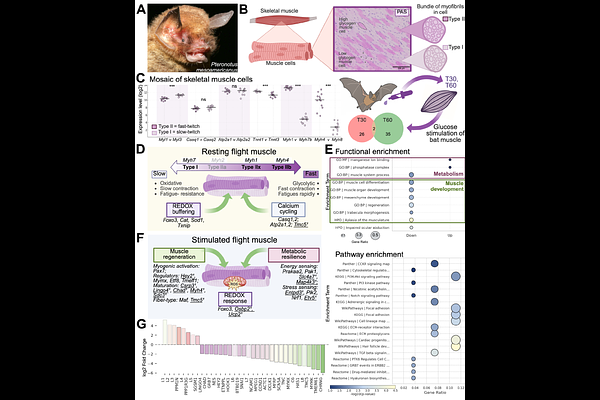From Development to Regeneration: Insights into Flight Muscle Adaptations from Bat Muscle Cell Lines

From Development to Regeneration: Insights into Flight Muscle Adaptations from Bat Muscle Cell Lines
Deng, F.; Pena, V.; Morales-Sosa, P.; Bernal-Rivera, A.; Yang, B.; Ghosh, S.; Castellano, L.; Katt, M.; Huang, S.; Maddera, C.; Yu, Z.; Rohner, N.; zhao, c.; Camacho, J.
AbstractSkeletal muscle regeneration depends on muscle stem cells, which give rise to myoblasts that drive muscle growth, repair, and maintenance. In bats, the only mammals capable of powered flight, these processes must also sustain contractile performance under extreme mechanical and metabolic stress. However, the cellular and molecular mechanisms underlying bat muscle physiology remain largely unknown. To enable mechanistic investigation of these traits (Graphical Abstract), we established the first myoblast cell lines from the pectoralis muscle of Pteronotus mesoamericanus, a highly maneuverable aerial insectivore. Using both spontaneous immortalization and exogenous hTERT/CDK4 overexpression, we generated two stable cell lines that retain proliferative capacity and differentiate into contractile myotubes. These cells exhibit frequent spontaneous contractions, suggesting robust functional integrity at the neuromuscular junction. In parallel, we performed transcriptomic and metabolic profiling of native pectoralis tissue to define molecular programs supporting muscle specialization. Gene expression analyses revealed enriched pathways for muscle metabolism, development, and regeneration, highlighting the supporting roles in tissue maintenance and repair. Consistent with this profile, the flight muscle is triglyceride-rich, which serves as an important fuel source for energetically demanding processes, including muscle contraction and cellular recovery. Integration of transcriptomic and metabolic data identified three key metabolic modules--glucose utilization, lipid handling, and nutrient signaling--that likely coordinate ATP production and support metabolic flexibility. Together, these complementary tools and datasets provide the first in vitro platform for investigating bat muscle research, enabling direct exploration of muscle regeneration, metabolic resilience, and evolutionary physiology.